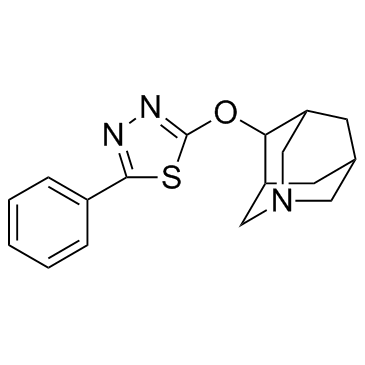| Description: |
Nelonicline (ABT-126) is a selective neuronal nicotinic receptor agonist. |
| Target: |
Neuronal nicotinic receptor[1] |
| In Vivo: |
The 0.03 mg/kg dose Nelonicline (ABT-126) has no significant effect on LIDs. Nelonicline at 0.10 mg/kg reduces LIDs by ~40%, while the 0.30 and 1.0 mg/kg Nelonicline doses decrease LIDs up to ~60%. The effect of Nelonicline (1.0 mg/kg) is also tested for its ability to reduce LIDs at a higher dose of L-dopa (15 mg/kg)/carbidopa (3.75 mg/kg). The higher dose of L-dopa leads to greater LID scores in vehicle treated monkeys. Nelonicline treatment reduces LIDs by 70%, after the morning dose of L-dopa and 60% after the aftemoon dose. The effect of Nelonicline is most pronounced during the latter weeks, possibly because of a greater decline with continued drug treatment. A washout is in progress to determine if LIDs return to vehicle-treated levels after Nelonicline discontinuation. There is no effect of the drug on Parkinsonism or cognitive ability. Overall, these data indicate that Nelonicline would be useful as an antidyskinetic drug in Parkinson's disease[1]. |
| Animal Administration: |
Monkeys[1] MPTP-lesioned monkeys are used. All monkeys have been administered MPTP and exhibited mild to moderate parkinsonism. All monkeys are orally gavaged with L-dopa/carbidopa twice daily, which lead to the development of stable abnormal involuntary movements or dyskinesias. The treatment groups are as follows: vehicle-treated (n=6), nicotine-treated (n=5), Nelonicline treated (set 1, n=5) and Nelonicline-treated (set 2, n=5). These latter two sets of monkeys have previously been given ABT-894 and ABT-107 but using somewhat different treatment regimens. The present study is done after a 7 wk washout period, when LIDs are similar in all groups. Nelonicline is administered orally in a small cracker 30 min before L-dopa (10 mg/kg) and carbidopa (2.5 mg/kg). Nicotine, a positive control, is provided in the drinking water. Nelonicline is tested at 0.03, 0.10, 0.30 and 1.0 mg/kg, with each dose of Nelonicline tested for 1 or 2 wk[1]. |
| References: |
[1]. ARYL SULFONOHYDRAZIDES. WO2015168616A1. |






















